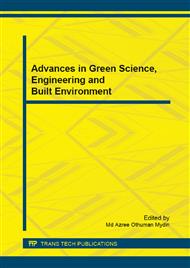[1]
A. Mohamed, Falsafah Dan Pemikiran Orang-Orang Melayu: Hubungan dengan Islam dan Kesenian, Penerbitan Kementerian Kebudayaan, Belia & Sukan Malaysia, Kuala Lumpur, (1978).
Google Scholar
[2]
M.A. Yahya, Simbolisme Dalam Seni Bina Rumah Melayu Kelantan (Symbolism in Malay House of Kelantan), Dewan Bahasa dan Pustaka, Kuala Lumpur, (1995).
DOI: 10.33656/manuskripta.v9i1.135
Google Scholar
[3]
A.A. Shuaib & O.F. Enoch, Integrating the Malay Traditional Design Elements into Contemporary Design: An Approach towards Sustainable Innovation, Procedia-Social and Behavioral Sciences. 129 (2013) 59–67.
DOI: 10.1016/j.sbspro.2014.03.648
Google Scholar
[4]
S. Abdul Rashid & S. Che Amat, The traditional Malay architecture: Between aesthetics and symbolism, Proceeding Seminar on Intellectual Property and Heritage Issues in Built Environment. 20- 21st July 2008, Kuala Lumpur. (2008).
Google Scholar
[5]
S. Abdul Rashid, Kajian Simbolisme Elemen-Elemen Estetik dan Ragam Hias Rumah Tradisional Melayu: Kajian Kes Seni Bina Gaya Pantai Timur, Universiti Sains Malaysia, (2007).
DOI: 10.17576/geo-2021-1702-24
Google Scholar
[6]
M. Surat, I.M.S. Usman, M.M. Tahir, I. Abdul Halim, N.L. Nik Ibrahim, Pendekatan Dasar Pemikiran Seni Bina Warisan Melayu Bagi Mendapatkan Keselesaan Hawa Serta Penyelesaian Masalah Iklim dan Persekitaran Dalam Seni Bina Masa Kini, Journal Design + Built. 2 (2009).
DOI: 10.17576/jkukm-2022-si5(1)-08
Google Scholar
[7]
A.A. Shuaib, Application of Kelantan Traditional Aesthetic Values into the Architecture of Contemporary Homes, Arts and Design Studies. 6 (2013) 15–25.
Google Scholar
[8]
A.M. Zamberi, Patani Dalam Tamadun Melayu, Dewan Bahasa dan Pustaka, Kuala Lumpur, (1994).
DOI: 10.33656/manuskripta.v9i1.135
Google Scholar
[9]
A.M. Zamberi, Langkasuka: Negara Melayu Pertama. Seminar Alam Melayu: Menjejaki Langkasuka. 2 June 2009. Universiti Kebangsaan Malaysia, Kuala Lumpur, (2009).
DOI: 10.17576/geo-2020-1603-15
Google Scholar
[10]
T.M. Rasdi, M. Ali, E. Nihan, S.A.I. Syed Ariffin, R. Mohamad & G. Mursib, The architectural heritage of the Malay world – The traditional houses, Johor Darul Ta'zim, Malaysia, (2005).
Google Scholar
[11]
N. Utaberta & N. Spalie, Evaluating the Design and Construction Flexibility of Traditional Malay House. Proceeding of the International Conference on Advanced Science, Engineering and Information Technology 2011, 14 - 15 January 2011, Putrajaya, Malaysia. (2011).
DOI: 10.18517/ijaseit.1.6.137
Google Scholar
[12]
K. Zumahiran & S. Ismail, Placement of Woodcarving in Malay Timber Houses of Kelantan and Terengganu. In Zawiyah Baba. (Ed. ) Warisan Seni Ukir Kayu Melayu. (pp.129-141), ATMA, Universiti Kebangsaan Malaysia, Selangor, (2008).
Google Scholar
[13]
S. Abdul Rashid, Evolusi Bentuk dan Makna pada Ragam Hias dalam Seni Bina Traditional Melayu, Jabatan Senibina Dalaman Fakulti Senibina, Perancangan dan Ukur UiTM Perak, (2008).
DOI: 10.17576/jkukm-2022-si5(1)-05
Google Scholar
[14]
A.H. Nasir, Traditional Malay Wood Carving, Dewan Bahasa dan Pustaka, Kuala Lumpur, (1987).
Google Scholar
[15]
F.A. Noor & E. Khoo, Spirit of Wood: The Art of Malay Woodcarving, Periplus Edition (HK) Ltd, Singapore, (2003).
Google Scholar


